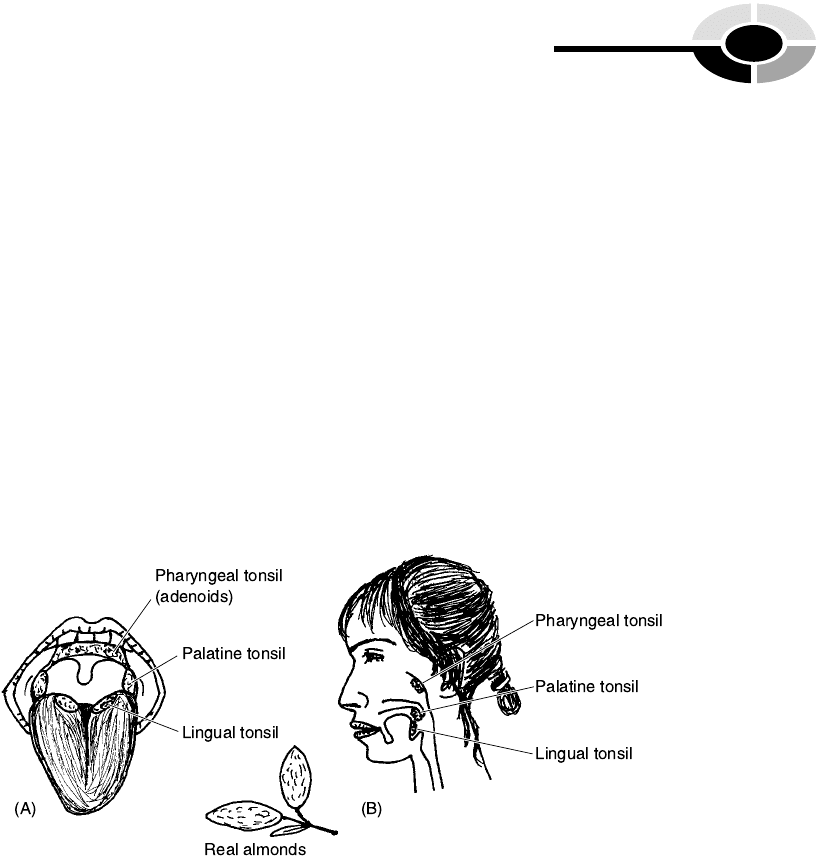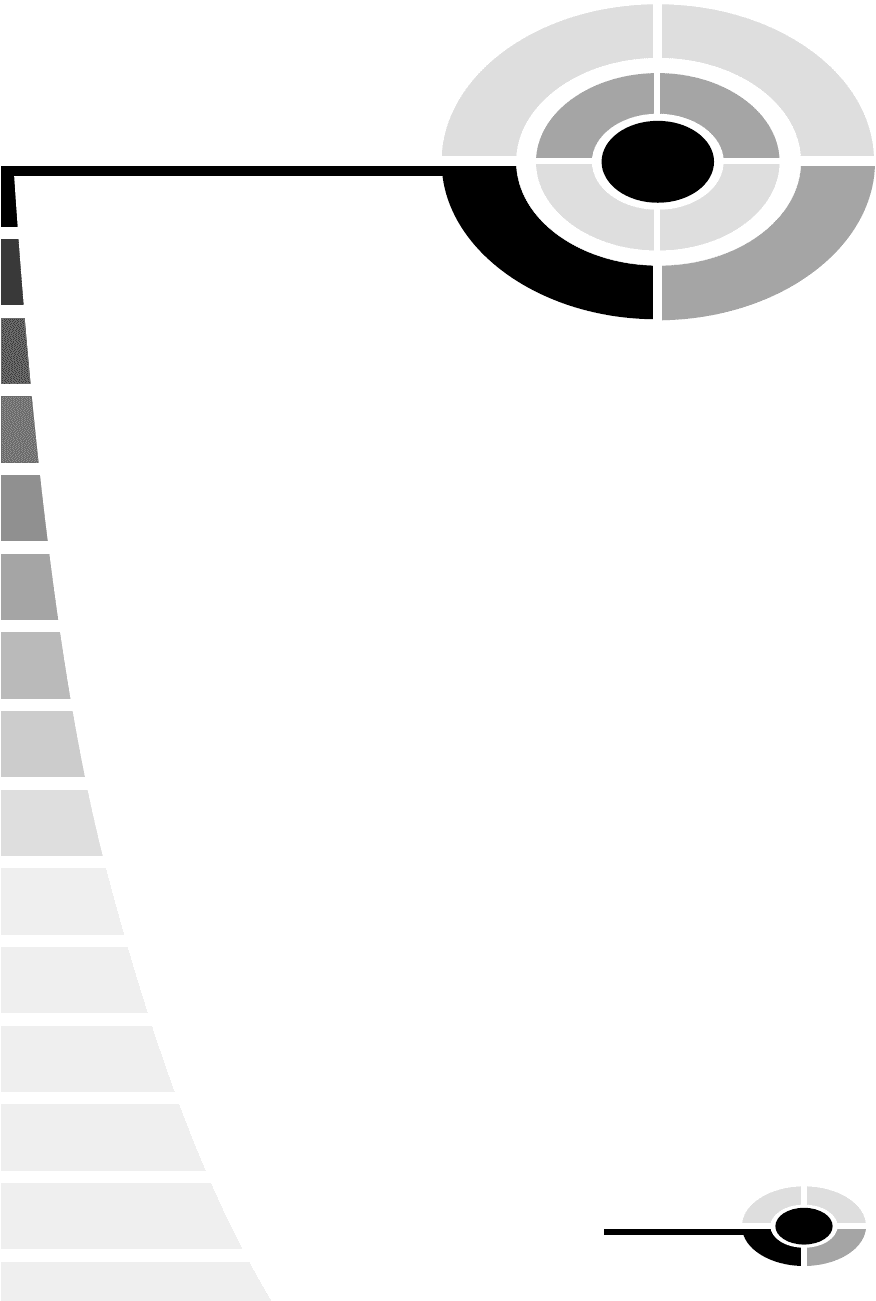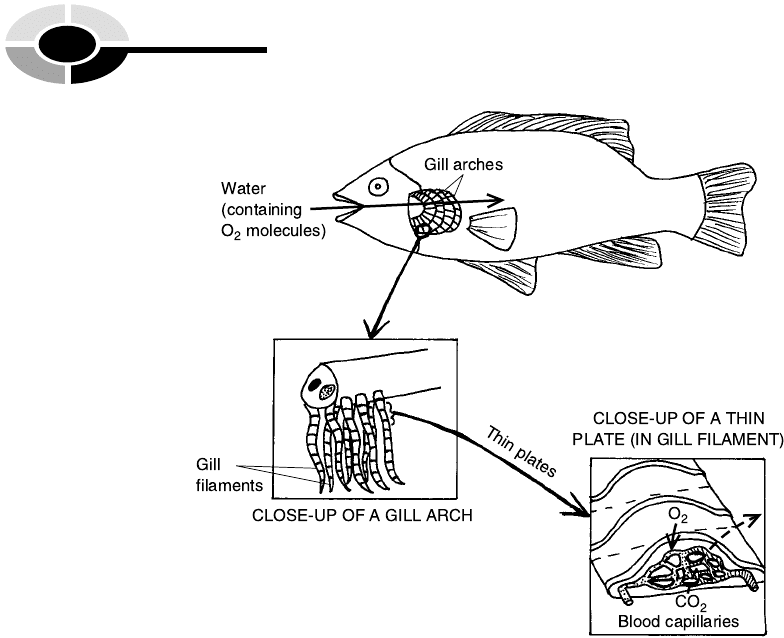Layman D. Biology Demystified: A Self-Teaching Guide
Подождите немного. Документ загружается.


wandering macrophages (mostly derived from monocytes). It is therefore an
important helper in phagocytosis of foreign invaders, such as bacteria, as well
as devouring fragments of broken erythrocytes.
The Tonsils: ‘‘Little Almonds’’ In the Back of
Our Throat
In addition to full-blown lymphatic organs, there are smaller masses of lym-
phatic tissue scattered here and there around the body. Prominent among
these are the tonsils (TAHN-sils). The tonsils are literally ‘‘little almonds’’
(tonsils) – oval, somewhat almond-shaped clusters of lymphatic tissue – lying
in the back of the throat (Figure 17.4).
In humans, there are five tonsils. The pharyngeal (fah-RIN-jee-al) tonsil is
the single uppermost mass, located in the portion of the pharynx (FAIR-inks)
or ‘‘throat’’ just behind the nose. The pharyngeal tonsil is also called the
adenoids (AD-uh-noyds), because it is rather big and ‘‘gland’’ (aden) ‘‘like’’
(-oid).
The two palatine (PAL-ah-tyn) tonsils, as their name indicates, are a pair of
tonsils lying on either side of the throat, just below the palate (PAL-aht) or
‘‘roof of the mouth.’’ Finally, there is a pair of lingual (LING-gwal) tonsils,
attached way back at the base of the ‘‘tongue’’ (lingu).
CHAPTER 17 Immune/Lymphatic Systems 307
[13:26 13/6/03 N:/4058 LAYMAN.751/4058-Alltext.3d] Ref: 4058 Layman: Biology Demystified All-text Page: 307 1-388
Fig. 17.4 The tonsils: ‘‘Little almonds’’ tucked away in our throats. (A) Frontal view.
(B) Side view.

TONSILLITIS
Since they are composed of lymphatic tissue, these five tonsils play minor
roles in body defense. They contain lymphocytes and macrophages that pha-
gocytose foreign invaders entering the nose, mouth, or throat. These invaders
naturally include various airborne bacteria and viruses.
Sometimes, however, the lymphatic tissue of the tonsils becomes over-
whelmed by a huge number of bacteria or viruses. In such cases, tonsillitis
(tahn-sihl-EYE-tis) may result. Tonsillitis is ‘‘an inflammation and swelling
of ’’ (-itis) the tonsils. This inflammation may be accompanied by a danger-
ously high fever. The operation of tonsillectomy (tahn-sihl-EK-toh-mee) or
‘‘removal of ’’ (-ectomy) the tonsils is then frequently performed.
[Study suggestion: Using your growing knowledge, write a single term that
literally means, ‘‘inflammation of the adenoids.’’ Why do you think that a
person afflicted with this condition might have trouble breathing?]
Quiz
Refer to the text in this chapter if necessary. A good score is at least 8 correct
answers out of these 10 questions. The answers are listed in the back of this
book.
1. Immunity literally translates to mean:
(a) ‘‘Soreness of the back’’
(b) ‘‘A condition of not serving’’
(c) ‘‘Open to infection’’
(d) ‘‘Guards of protection’’
2. The word, lymph, derives its name from what specific characteristic?
(a) Dark red color of the fluid
(b) Clear, watery fluid contents
(c) Walking with a ‘‘limp’’ when the lymph circulation is blocked
(d) Milky, murky sludge
3. The lymph is mainly created due to the process of:
(a) Simple diffusion
(b) Phagocytosis
(c) Antigen–antibody reactions
(d) Pressure-driven filtration
[13:26 13/6/03 N:/4058 LAYMAN.751/4058-Alltext.3d] Ref: 4058 Layman: Biology Demystified All-text Page: 308 1-388
PART 4 Anatomy and Physiology of Animals
308
1, Disorder

4. The ultimate destination of all lymph:
(a) Small masses of lymphatic tissue
(b) Extremely large lymph veins
(c) Blood-containing arteries
(d) Blood-containing veins
5. Act as scouts that first chemically detect and signal the presence of a
foreign invader:
(a) Plasma cells
(b) Thymic lymphocytes
(c) Antigen–antibodies
(d) B-lymphocytes
6. A bone marrow lymphocyte:
(a) Readily differentiates into a plasma cell
(b) Is a major producer of antibodies
(c) Usually changes into a T-cell
(d) Basically is identical to an erythrocyte
7. Amoeba-like cells that are active in achieving immunity:
(a) B-lymphocytes
(b) Plasma cells
(c) Erythrocytes
(d) Wandering macrophages
8. An endocrine gland that secretes thymosin:
(a) Spleen
(b) Pancreas
(c) Thymus
(d) Thyroid
9. Both the spleen and red bone marrow are involved in the functions of:
(a) Hematopoiesis, recycling of old erythrocytes, and phagocytosis
(b) Antigen–antibody reactions, only
(c) Digesting important types of foodstuffs
(d) Body movement and support of the vertebral column
10. The type of tonsil also known as the adenoids:
(a) Lingual
(b) Palatine
(c) Zygomatic
(d) Pharyngeal
CHAPTER 17 Immune/Lymphatic Systems 309
[13:26 13/6/03 N:/4058 LAYMAN.751/4058-Alltext.3d] Ref: 4058 Layman: Biology Demystified All-text Page: 309 1-388

The Giraffe ORDER TABLE for Chapter 17
(Key Text Facts About Biological Order Within An Organism)
1. ____________________________________________________________
2. ____________________________________________________________
3. ____________________________________________________________
4. ____________________________________________________________
The Dead Giraffe DISORDER TABLE for Chapter 17
(Key Text Facts About Biological Disorder Within An Organism)
1. ____________________________________________________________
[13:26 13/6/03 N:/4058 LAYMAN.751/4058-Alltext.3d] Ref: 4058 Layman: Biology Demystified All-text Page: 310 1-388
PART 4 Anatomy and Physiology of Animals
310

[13:26 13/6/03 N:/4058 LAYMAN.751/4058-Alltext.3d] Ref: 4058 Layman: Biology Demystified All-text Page: 311 1-388
311
CHAPTER
18
The Respiratory
System: Breath of
Life
Chapter 17 talked about the lymphatic system and its circulation. But
Chapter 17, which deals with the respiratory (RES-pir-ah-tor-ee) system,
has much more in common with the cardiovascular or blood circulatory
system.
Respiration versus Ventilation
Respiration literally means ‘‘the act of ’’ (-tion) ‘‘breathing’’ (spir) ‘‘again’’
(re-). In actual usage, however, respiration is the process of gas exchange
between two or more body compartments. Consider, for example, external
respiration in mammals (Figure 18.1). External respiration is gas exchange
Copyright 2003 by The McGraw-Hill Companies, Inc. Click Here for Terms of Use.

(such as that of O
2
gas and CO
2
gas) that occurs between the blood in the
pulmonary capillaries and the air within the alveoli (al-VEE-oh-lie). In mam-
mals, each alveolus (al-VEE-oh-lus) is a ‘‘little cavity’’ (alveol) or microscopic
air sac within the lung.
Internal respiration, in contrast, is gas exchange that occurs between the
blood in the systemic capillaries and the fluid within the tissue cells. Internal
respiration, then, is the way mammalian cells acquire oxygen and give off
carbon dioxide.
During breathing, air is inhaled from the atmosphere, and it enters the
millions of alveoli within the lungs. We know that breathing, itself, involves
pulmonary functions: that is, those ‘‘pertaining to’’ (-ary) the ‘‘lungs’’
(pulmon). An appropriate term here is ventilation (ven-tih-LAY-shun), the
‘‘process of ’’ (-tion) ‘‘fanning or blowing’’ (ventil). A ventilation system in a
large building, for example, blows stale air out, and sucks fresh air in. A
similar situation exists for the lungs. Therefore, pulmonary ventilation is the
sucking of air into the lungs, followed by the blowing of air out of the
lungs.
INSPIRATION VERSUS EXPIRATION
The technical terms concerning pulmonary ventilation are inspiration (IN-
spir-ay-shun) on the one hand, expiration (EKS-pir-ay-shun) on the other
hand. Inspiration is the process of sucking air into the lungs, while expiration
is the process of blowing air out of the lungs.
Summarizing these relationships, we can say that:
PULMONARY VENTILATION ¼ INSPIRATION þ EXPIRATION
while
RESPIRATION ¼ The Process of Gas Exchange between Various
Body Compartments
Pulmonary ventilation is the way that the body takes in fresh air (by
inspiration) and gets rid of stale air (by expiration). And respiration (external
and internal) is the means by which O
2
and CO
2
are exchanged between
various compartments while the air is within the body.
These very basic inter-relationships are diagrammed for humans and other
mammals within Figure 18.1.
[13:26 13/6/03 N:/4058 LAYMAN.751/4058-Alltext.3d] Ref: 4058 Layman: Biology Demystified All-text Page: 312 1-388
1, Order
PART 4 Anatomy and Physiology of Animals
312

Fish Gills: Respiration and Ventilation through
the Water
Land-dwelling animals – mammals, birds, reptiles, and amphibians – use air
as a means for both respiration and ventilation. And associated with this
characteristic, they have developed lungs, which inflate and deflate with air.
Aqueous (water-dwelling) animals, such as fish, however, ventilate water
through their mouths (Figure 18.2). The water passes through the pharynx
(throat), and then out across a set of curved gill arches. The gill arches consist
of a series of thin, thread-like gill filaments. Thin plates on the surfaces of the
gill filaments serve as the actual points of respiration (gas exchange). Water
passes through the narrow gaps between the plates and moves in a single
CHAPTER 18 The Respiratory System 313
[13:27 13/6/03 N:/4058 LAYMAN.751/4058-Alltext.3d] Ref: 4058 Layman: Biology Demystified All-text Page: 313 1-388
Fig. 18.1 Respiration versus ventilation within humans.
1, Web

direction, out towards the edge of the operculum (oh-PER-kyuh-lum) or gill
‘‘cover.’’
As the water passes, O
2
molecules diffuse out of the water, and into tiny
blood capillaries. Simultaneously, CO
2
molecules diffuse out of the fish’s
bloodstream, and into the water. This mechanism for gas exchange is very
effective. A limiting problem, however, is that the gill arches are very soft and
tend to easily collapse. There is also no defense mechanism to protect gill
arches in fish from dehydration. [Study suggestion: Ask yourself the following
question: ‘‘So, why can’t most fish just use their gills and extract O
2
from the
air? Why can’t most fish breathe outside of the water?’’ Use the preceding
hints in your reading to help you.]
The Path of Airflow in Humans
‘‘When humans take in air by inspiration, what is the sequence of body
structures through which the air passes?’’ the curious-minded reader might
well ask. The answer is depicted within Figure 18.3.
[13:27 13/6/03 N:/4058 LAYMAN.751/4058-Alltext.3d] Ref: 4058 Layman: Biology Demystified All-text Page: 314 1-388
PART 4 Anatomy and Physiology of Animals
314
Fig. 18.2 Fish gills: Extracting oxygen from the water.

THE UPPER RESPIRATORY PATHWAY
Lying above both lungs is the upper respiratory pathway. This pathway begins
with two cavities – the nasal (NAY-sal) cavity and the oral (OR-al) cavity.
The nasal cavity lies within the ‘‘nose’’ (nas), while the oral cavity is
situated behind the ‘‘mouth’’ (or). These are the first two body structures
that inhaled air usually enters. From both of these cavities, the air goes back
into the pharynx (throat).
Situated at the lower end of the pharynx, one sees the larynx (LAIR-inks).
The larynx or ‘‘voice box’’ is a box-shaped collection of cartilage plates held
together by dense fibrous connective tissue. Like the bow of a ship, the
laryngeal (lah-RIN-jee-al) prominence is a projection of cartilage sticking
out from the front of the voice box. Stretched across the interior of the larynx
are the two vocal (VOH-kal) cords. The vocal cords are two straps of highly
elastic connective tissue, which vibrate with the passage of air through the
larynx. These vibrations create the ‘‘voice’’ (voc) sounds.
The glottis (GLAHT-is) is the name of the tapered, ‘‘tongue’’ (glott)-
shaped opening between the two vocal cords. Closely related to the glottis
is the epiglottis (EH-pih-glaht-is). The epiglottis is a highly flexible flap of
cartilage literally located ‘‘upon’’ (epi-) the glottis. The epiglottis thus serves
as a flexible lid over the top of the larynx or voice box. When a person
swallows, the food or liquid normally pushes the epiglottis shut. This usually
prevents food or liquid from entering the larynx and the rest of the respira-
tory pathway.
Below the larynx is the trachea (TRAY-kee-ah) or main ‘‘windpipe.’’ The
trachea is stiff and noncollapsible, due to the presence of horseshoes of
cartilage within its walls.
THE LOWER RESPIRATORY PATHWAY
As the trachea branches, the lower respiratory pathway is created. The right
and left primary bronchi (BRAHN-kigh), the first branches, then enter the
two lungs. The primary bronchi just keep branching. Eventually, a set of
bronchioles (BRAHN-kee-ohls) or ‘‘little bronchi’’ emerges. Much like an
inverted (upside down) tree, the respiratory tree thus consists of a succession
of ever-smaller and more numerous branches – the larynx, trachea, bronchi,
and bronchioles.
At the furthest tips of the bronchioles, hang clusters of thousands of
alveoli. (Picture the many olives suspended from the branches of an
inverted olive tree.) Each alveolus is essentially a collapsible, extremely
CHAPTER 18 The Respiratory System 315
[13:27 13/6/03 N:/4058 LAYMAN.751/4058-Alltext.3d] Ref: 4058 Layman: Biology Demystified All-text Page: 315 1-388

thin-walled air sac. It is across the walls of the alveoli, and their close
neighbors, the pulmonary capillaries, that external respiration occurs. By
this means, remember, oxygen contained in the inhaled air finally enters the
bloodstream.
[Study suggestion: Look very carefully at Figure 18.3. Which structure
mentioned in this section do you think represents the so-called ‘‘Adam’s
apple’’ in males? Why?]
[13:27 13/6/03 N:/4058 LAYMAN.751/4058-Alltext.3d] Ref: 4058 Layman: Biology Demystified All-text Page: 316 1-388
PART 4 Anatomy and Physiology of Animals
316
Fig. 18.3 The respiratory tree.
